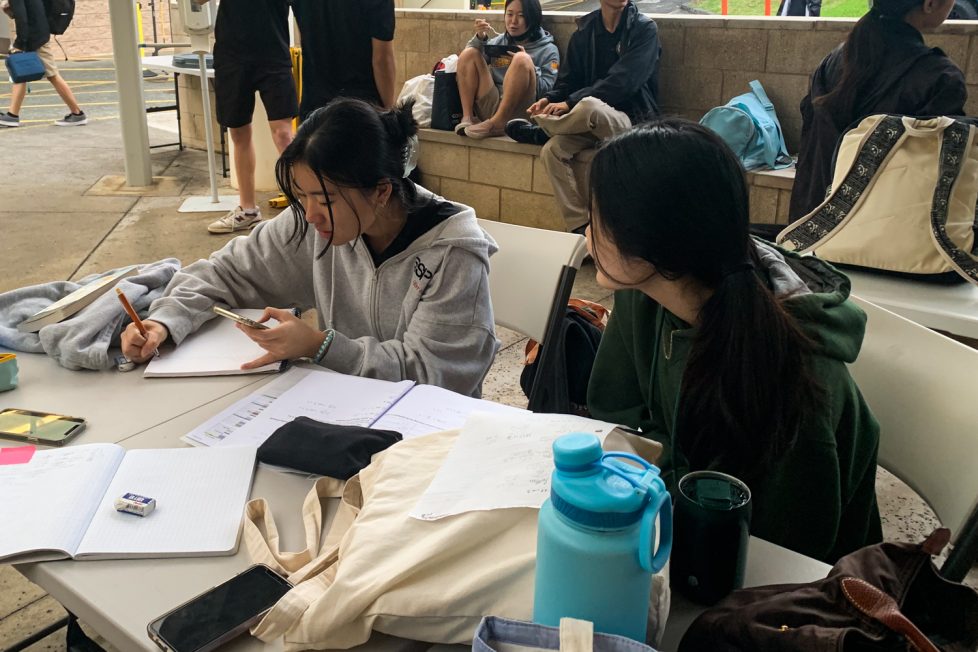Students, Administration Grapple with Dress Code


The intent of HBA’s dress code, as defined by the student handbook, is to “express the values of the school, promote unity, and enhance the learning environment by training students to carry themselves in a professional and appropriate manner.” However, not all students buy this reasoning. “Professionalism,” said junior Dylan Okamura, “shouldn’t be defined by the way you present yourself in your clothes, but by the way you act. I could wear a T-shirt and shorts and yet be completely professional in any situation, whereas I could wear a suit and act like a child.” Okamura believes that even if he wasn’t wearing the school uniform, he would still be able to learn and work diligently in the same way that he does when wearing one.
Senior Noelle Nagaishi shares Okamura’s point of view and feels that a plain and simple non-uniform jacket is just as professional as an HBA-approved one. “We are wearing what the core of a uniform is,” she stated, “and adding a jacket with, of course, non-vulgar things on it is not that big of a deal.” As a senior, Nagaishi says all of her uniform jackets don’t keep her warm anymore as they have grown old and ratty. As a result, she finds it easier to wear a non-uniform jacket she already owns rather than buy a new HBA hoodie or jacket, which can cost up to thirty five dollars. “Uniforms are already really expensive and the jackets are just like another add-on thing you have to buy, so I prefer wearing something I already have,” she said.
In addition to wanting a more relaxed dress code, many students also hope that the school updates its dress code according to the changing times when it comes to accessories. For example, senior Dawson Coover points out that earrings should no longer be considered an accessory that is strictly for women. “I think, judging the way times have changed, guys should be able to wear things like earrings and nose rings,” he said. Coover wears earrings and doesn’t think that they make him less masculine. “I can understand [the rules against cross-dressing] and not wearing things like skirts as a guy,” he added, “but I feel like [wearing earrings] doesn’t make a guy feminine or any less professional.”
When asked to address this issue, high school principal Elton Kinoshita acknowledged that while times have changed, the HBA community has “a wide range of ideas and opinions” and that finding consensus may take some time. He explained, “There are some adults who are more traditional and others who are open for some changes, so we’re hoping to find a balance of parties.” Although Kinoshita said that he “cannot promise changes,” he said that he will keep an open mind when reviewing the dress code.
Many students are also frustrated with the way the rules are being enforced. Okamura finds that the school is not consistent; the junior noted that first time violators are more likely to receive demerits while repeat rule-breakers are getting let off with verbal warnings. “There are some times where I feel like the handling of the [dress code] situation just depends on the day or the teacher,” he said. Coover shares Okamura’s frustration, stating that “there’s definitely some teachers who don’t enforce the dress code on guys but do for girls, and some who do the opposite and enforce it on guys but not girls.”
History teacher Robert Weismantel acknowledged that checking if students are in dress code can sometimes take the back seat when teachers are trying to get their lessons started. At the beginning of class, for example, he is “so focused on taking attendance and trying to get [his] computer ready and the lesson going, that sometimes [checking if students are in dress code] aren’t as high of a priority for [him].”
Kinoshita said that the administrators are making an effort to consistent and that vice principal Jeroldine Tsuha has been “directed to take a stronger stand” on the matter. Since the start of the second semester, according to Kinoshita, the number of students receiving demerits for dress code violations has increased. “Mrs. Tsuha has been cautioning certain students, especially if they’re repeat offenders, because you can [not only receive demerits for being out of dress code, but you can also] get demerits for insubordination,” he said.
Advocating for more student voices on the matter of dress code, Kinoshita hopes that students will speak up via student representatives. “When we come up with the names of the representatives, and I’ll work with Mrs. Tsuha and Mrs. Yasutomi [Student Activities Director], I hope to make sure that the students have the chance to talk to their representatives and come up with a consensus that is a true representation of the overall voice of the student body,” he said.
While Kinoshita believes that traditions are important, he added that “every once in a while, one needs to review and see if the tradition still serves its purpose, and the purpose of our dress code is comfort, modesty, and the image we are trying to project.” In the meantime, the high school principal encouraged students to be patient. “We will be reviewing everything,” he said, “but until then, please follow the policy, because we are held to enforce it, and we will continue to do that until we make changes.”
